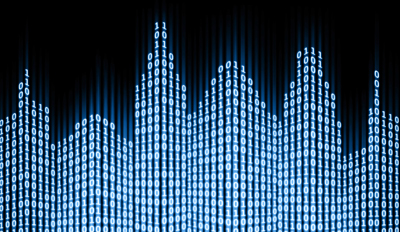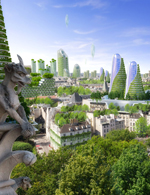You are in: Home page > Magazine Archive > But how bad this "Smart City"!

The digital city
The rhetoric of the Smart City comes from here. From the concept that digital networks, suitably integrated and considered as structural system, can turn the contemporary metropolis to a balanced and sustainable dimension again. A wired city as a source of development. In fact the term Smart City has taken different values, assigned time to time by academic disciplines, professional interests, marketing and business lobbies, which have oriented not always converged purposes. What I feel, by drawing a kind of interpolation between the various interpretations, it is that the Smart City already exists in urban circumscribed episodes or in individual buildings, largely controlled by the home or urban automation. It is not utopia, it is the theory of a reality which takes shape day by day. It will become a sort of protocol for urban regeneration based on interactivity and communication. The aim seems to save energy, improve health and mobility, make services more efficient and jobs more productive. An engine, a sort of city-computer, where the hardware is made by buildings and infrastructures and the software by integrated digital networks. So an efficient city in absolute sense. So far this is also acceptable. The problem is when these goals and these procedures are considered able to generate architectural form, or when considered sufficient to return quality to the city. An urban quality that derives from "efficiency" makes think more about dystopia of Fritz Lang's Metropolis that utopia of the New City of Sant'Elia.
I think that the scientific experience should not be only the application of processes that allow the transit from technological innovation to its implementation, but a substantial unity of the cognitive process, in which, at the same time, you have to think by scientific concepts and shaped forms: So, the city will be "beautiful", if the "form" will be imagined.
In a recent conference on the Smart city, Rem Koolhaas (*), although appreciating the effectiveness of new digital technologies and the need to create synergies between different disciplines, pointed some critical issues about the real possibility to innovate the city relying on these principles. According to Koolhaas, I do not think that the metropolis of the future can result its shape from a network system designed to monitor working conditions, mobility and free time, individual or family dates, however finalized to the development of business. It would be dangerous this transfer of authority from the political to the digital domain, from the administrator to the manager, from the architect and designer to the computer technician.
Still following the Koolhaas thought, the idea of the city, today metropolis, it is generally applied to the concept of community. the architect is its bearer and should devote to this, just in case by reformulating the concept of community. Since the triumph of the market economy in the late 1970s, architecture no longer expressed public values but instead the values of the private sector. It is clear that in the digital realm the architects will have to work together to ¥-€-$ (Yen / Euro / Dollar), that governs every field of knowledge and action. A true regime that had a great impact to the city and the way of understanding the city. The metropolis has become a place of safety, but safety for the power of the market. On the city today there are no utopias, nor theories or manifestos. We stopped thinking about the city at the exact moment of the explosion of the metropolis in the developing world. So the metropolis has triumphed and the Smart City with its technological devices to control occupied the cultural vacuum that has been created.
Koolhaas continues by noting how the protagonists of a crowded race for the leadership of the Smart City practice the rhetoric of apocalypse, identifying a variety of disasters: the effects of climate change, the aging population, the crisis of infrastructures and mobility, the supply of water and energy , the waste disposal. Real problems, but they are not presented as the results of management or administrative lacks, but as solvable under the slogan “fix leaky pipes, save millions”. No matter the extent of the problem, but the amount of business that is built on. The commercial motivation corrupts the same problem that should be solved, getting to the extreme point that to save the city, we may have before to destroy it.
The existential spaces of mobility and permanence in the Smart City will be equipped with detection devices more and more sophisticated. The car will be monitored its movements and perhaps remote-controlled from the satellite. The "elements of living", like the wall, the floor, the door, the ceiling, the stair, that Koolhaas exposed in the recent Exposition of Architecture - Biennale 2014, with an analytical list of both their historical roots and form and using, perhaps will disappear, evolving with the global surveillance system. The house, in the home automation, will be transformed into a sensitive automated cell, full of devices such as automatic windows that can be opened only at certain times of the day; the floors with sensors so that the change in a person’s position from the vertical to the horizontal; the heating applied to people, as to form mantles of heat shield walking with them. And to address the essential need for privacy, says Koolhaas, “a Faraday cage is a necessary component of any home: a safe room in which to retreat from digital sensing and pre-emption”.
All this seems more science fiction than true innovation of living the metropolis. It is a rhetoric that provides easy, emotional and ephemeral patterns. A system too obvious to reestablish that trust in technology and progress that modernity had inspired and that now seems lost. Too much built on the exaltation of a universal informatics science based on individual well-being bubbles, that isolate from the public sphere. And everything, formless, will make "ugly and stupid" the city. The Smart City is commonly represented with easy impact images. By day with soft shapes and bright colors: green or rainbow dominate reassuring images of a clear and fragrant metropolis, with trees and forests also vertical, rivers or lakes with sails, bicycle paths and highways sliding, in which the technology is invisible. At the contrary by night the urban highways innervated by flowing fluid in a constant energy consumption, including polychrome and equally shining "intelligent" towers. Day and night so translate the Smart City in an pseudo-environmentalist oxymoron, suspended between respect for the environment and the development of electronics. Other times, more prudently, the Smart City appears in form of ideogram or diagram annotated from the usual slogans of sustainability and energy conservation; definitely a more honest representation, that stops before defining its morphology.
To date, the debate on the Smart City, mostly promoted by the great powers of digital technology (ICT - World, Information and Communication Technology), involves building contractors, materials producers, governors and local administrators, environmentalists, researchers and teachers of computer science and technology, but few architects, in particular, very few researchers or designers of the city. A river of euro, more than 70 billion, was channeled by the Horizon 2020 program on macro themes, within which, however, is difficult to find space for the architectural and spatial regeneration of the contemporary city. We know how the urban design, by the studies on the historic city that marked the Italian and European experience between the Sixties and the Eighties, has fallen into crisis in the Nineties. In fact, it lost control of landscape by the urban sprawl, it could not reorder its disciplinary code in the urban transformation (the small scale) and the government of the territory (the large scale).
Ultimately today the Urban Design finds difficulty to communicate with the new technological dimension of the metropolis. The path of reconstruction of a common profile of urban design will be difficult and long. I will just conclude these notes indicating certain goals. 1. Building a new city, transforming a "volume zero", so it builds as it demolishes. 2. Intervening in the landscape for rarefaction or densification, depending on the case: the one part protection and the other completeness. 3. Working in the ancient city for regeneration and recycling of the existing, in the suburbs for separate parts. 4. Returning to work about the infrastructure system, which we studied in the last fifteen years, even in their formal characterizations, but receiving network and communication cabling. 5. Welcoming into the project signs new technical and new technologies, following the principle that architectural form must become the synthesis of the various knowledge once again.
(*) Parts of this paper are a free interpretation of intervention that Rem Koolhaas held under the title My thoughts on the smart city, at the conference "High Level Group meeting on Smart Cities', Brussels, 24 September 2014. The original text was published on the website www.metalocus.es.















